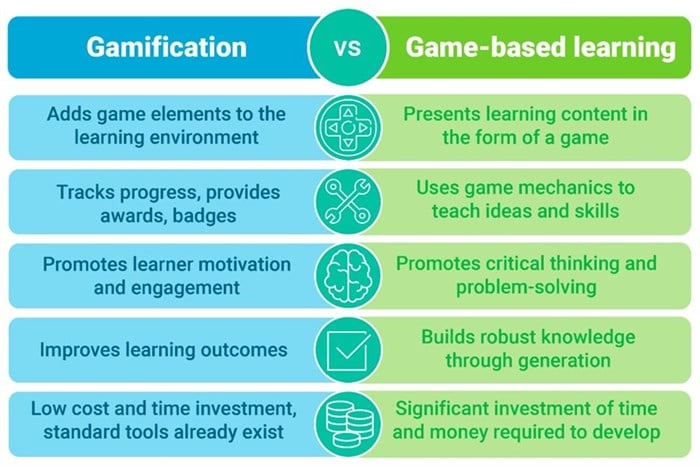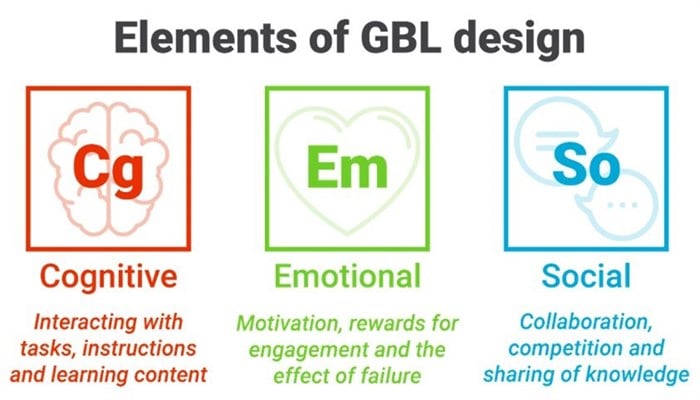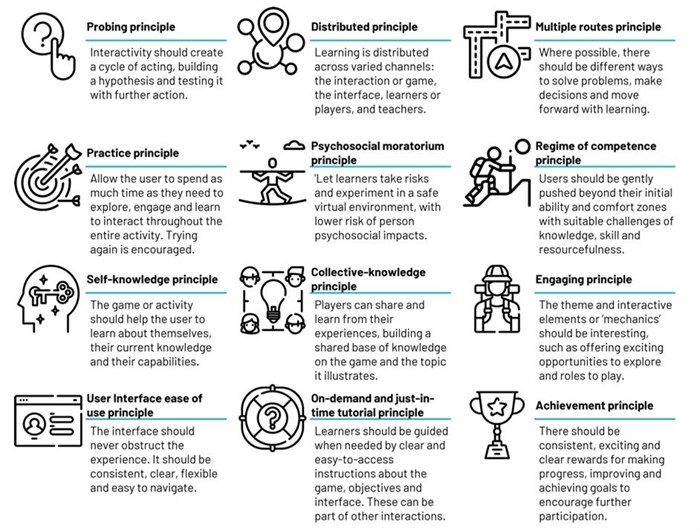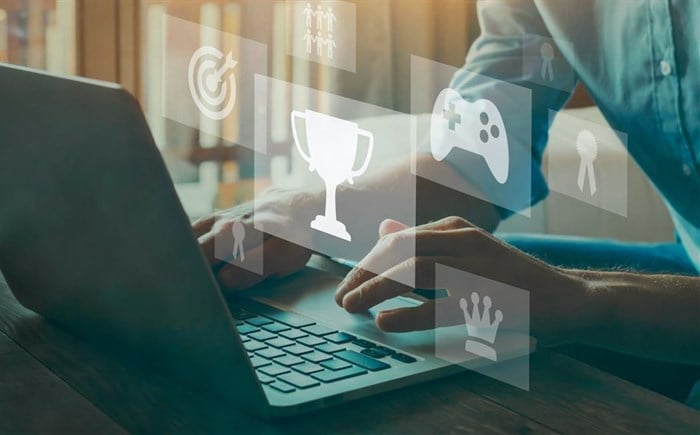Recent trends reveal that games are becoming increasingly important to younger generations (Saxena and Mishra, 2021: 2-3). Evidence also suggests that students have a positive attitude toward using commercial games to practice higher-order 'graduate skills', such as problem-solving, communication and resourcefulness (Barr, 2018: 283). This general positive regard for technology provides educators with an opportunity to leverage students' interests by creating appealing learning experiences through games (Anastasiadis et al., 2018: 140). As such, as educators, it is crucial that we consider the value of games in order to respond to these generational and technological trends.
Game-based learning (GBL) vs gamification
There are two broad ways in which games currently feature in education, namely gamification and game-based learning (GBL). These approaches differ in both their purpose and design, and as a result, they provide different types of value.

Figure 1: Gamification vs GBL (Source: EDGE Education (Pty) Ltd, 2022; and Flaticon)
Gamification
Gamification has made waves over the past few years, as it has revolutionised the way the world has approached productivity, marketing, health and, most importantly, education (Fitz-Walter, 2020). It is typically defined as the practice of adding one or more game elements to a non-game context (Rasure, 2021). Importantly, gamification is not synonymous with using games as an educational tool – in other words, it does not refer to ‘play’ as a mode of instruction. Instead, gamification is best understood as an incentive system that exists to encourage students to continue their educational journey (Rasure, 2021).
There is ample evidence that gamification has positive effects on students’ motivation, the frequency of their interactions, and their learning outcomes (Huang et al., 2020: 2; Koivisto and Hamari, 2019: 191-192; and Putz et al., 2020: 3). A few key examples of gamification include progression tracking (scoreboards, quests, badges), social interaction (cooperation, teams, networking) and immersion (avatars, storytelling, role playing) (Majuri et al., 2018: 14). When used effectively, these tools can motivate students to be more present throughout their learning journey.
Some researchers use a different definition of gamification that includes the elements of ‘game-based mechanics, aesthetics, and game-thinking to engage people, motivate action, promote learning, and solve problems’ (Kapp, 2012: 10). This definition identifies more accurately the aspects of games that can be implemented in action and learning. The mechanics and aesthetics make games feel more enjoyable by presenting the element of play, while the component of game thinking generates knowledge through engagement with digital activities.
Game-based learning (GBL)
This brings us to the concept of GBL, which is ‘the act of designing interactive learning activities that can gradually convey concepts and guide students towards an end goal’ (Anastasiadis et al., 2018: 141). Here, the game is the medium through which instruction is given and education is facilitated. This is what makes GBL a form of purposeful play, as opposed to a leisure activity. GBL is a particularly effective mode of instruction, because it increases students’ engagement with content through problem-solving and critical thinking exercises.
Students are able to generate more robust knowledge through games than through traditional rote learning methods, provided that they are given the appropriate support by facilitators when engaging with the game environment (Kurt, 2021). This is known as ‘generative learning’, and is just one of the principles that makes GBL activities so effective. Generative learning aligns with the theory of constructivism, which claims that students develop knowledge incrementally by interacting with new subject matter and reflecting with instructors and peers. As classrooms become more student-centred, an increased emphasis is placed on independent exploration and discovery (Zeng et al., 2020: 188). In this way, as learner interest in technology and games continues to grow, so does the potential of GBL.
Purposeful play
The emphasis on play is what differentiates games and GBL from other forms of instruction. It would be a mistake to regard play purely as pointless diversion – although, there is debate as to whether shifting from an aim of diversion to a more outcome-based approach changes the very nature of a ‘game’ (González-González and Navarro-Adelantado, 2021: 2). Nevertheless, all humans engage in play regardless of their age, and the act of play can be a powerful vehicle through which to explore ideas, experiment and synthesise information.
For this reason, González-González and Navarro-Adelantado (2021: 12) suggest that the experience of play is two-fold, and that it involves both the process and the result. Gamification often focuses only on the latter point – i.e. emphasising rewards for interactivity, without fully exploring the ways in which learners can learn through play. As such, gamification can have the unintended consequence of leaving some learners feeling demotivated, as the scores, badges and achievements become devoid of meaning (González-González and Navarro-Adelantado, 2021: 12). GBL avoids this pitfall by focusing on the process of interaction, and by ensuring that other elements of game-like experiences are incorporated.
In order to make play purposeful, there are three areas that games must use to engage students, namely cognitive, social and emotional elements (Klein, 2021: 6).
- The cognitive elements are the tasks involved, the instructions and interactions required, and the learning content being communicated.
- The emotional component relates to our motivations for engaging, such as the extrinsic rewards offered by achievements or the intrinsic motivation of curiosity when presented with a relevant scenario. Penalties or fail states can also be an emotional element – these should be educational, rather than punitive, so as to encourage experimentation and a willingness to try again.
- Finally, games often have a social dimension, as players may collaborate, share their results and ask one another for help. Games and GBL are an important tool for social approaches to learning, as they can create an engaging environment for collaboration, competition and sharing of knowledge and experiences. Here, when students engage with one another, they are also generating knowledge together as a community.

Figure 2: The three elements of GBL design (Source: EDGE Education (Pty) Ltd, 2022; and Flaticon; adapted from Klein, 2021: 6)
These three elements of GBL design enable us to understand which game mechanics (e.g. reward systems) are required in order to bring about a desired result (e.g. higher engagement). However, these are not the only guidelines that are necessary to provide an effective game-based learning experience (GBLE).
Principles of GBL
In order for a game to be effective, players must be able to learn how it works. A successful game – whether strictly educational or for entertainment purposes – should facilitate what Rosario and Widmeyer (2009) call a ‘constructivist gaming learning environment’, in which a user can learn the game’s rules and functions. In this space, the student is an active part of the learning process, and they create meaning and understanding by interacting with the learning environment – i.e. a game or interactive virtual space (Rosario and Widmeyer, 2009: 298).
Constructivist gaming has wide applications – from strictly educational games, to popular online games like World of Warcraft. The best examples of games that teach users from the moment they start playing are underpinned by a similar set of principles that have been well tested over time (Klein, 2021: 5). These principles, some of which have been borrowed from the field of game design, serve as a framework or set of tools for the designer who creates GBLEs. They are also useful for educators and facilitators to understand in order to support students in the learning environment effectively. The following figure outlines 12 best practice principles for GBL design.

Figure 3: The principles of GBL design (Source: EDGE Education (Pty) Ltd, 2022; and Flaticon, adapted from Rosario and Widmeyer, 2009: 290–292
It is important to note that few games or GBLEs display all of these principles (Rosario and Widmeyer, 2009: 298). Therefore, these principles should rather be viewed as desirable best practices for designing effective GBLEs, and as tools for fostering constructivist game learning environments.
Designing game-based learning experiences (GBLEs)
Integrating GBL into an existing syllabus requires careful planning and design. González-González and Navarro-Adelantado (2021: 13–14) suggest focusing on the game-based interaction as part of a larger project, and as an experience made up of both rules and symbolic content. In other words, when designing and integrating GBL in any context, we need to pay attention to three areas (González-González and Navarro-Adelantado 2021: 4–7):
- Mechanics: The rules, or how the interactive elements work together to produce a game. These include points or achievements, as well as the different elements that a player interacts with.
- Dynamics: The result of the ways in which the mechanics function together as a system. For gamification, the dynamics may simply be extrinsic motivation from achievements to attempt more tasks. GBL seeks to develop an interesting system of interactive mechanics that can illustrate a concept or support learning outcomes directly.
- Aesthetics: Factors that shape how a player relates to the game, such as visual elements, narrative and theme. These factors can influence the fun that students have, as they reinforce the dynamics, while also providing a sense of play.
Let’s look at an example from the world of educational games. Flutter: Butterfly Sanctuary is a mobile game with an educational purpose baked into its design, as players are taught about different butterfly species of the world. As you can see in their trailer, the game's visuals and gameplay are designed to engage players while they learn about these insects. In the game, players collect butterflies to earn points, and aim to complete collections of geographically related species. The butterflies produce the game’s resources, and each insect’s artwork reflects the shape and colour of real-world butterflies. Missions require players to recognise and identify different species after being presented with factual content in menus. By placing educational content throughout the game, the content becomes part of Flutter’s mechanics, dynamics and aesthetics (Goodwin, 2016: 18).
Flutter is a case study that lends weight to the value of games in creating deeper learning. Research indicates that the game increases players’ awareness of real-world butterflies and their desire to learn more about them through voluntary research (Goodwin, 2016: 52). Here, we can see the pipeline of a GBLE. The mechanics involve the educational content; for example, what the butterflies are called, what they look like and where they are from. These elements are part of the dynamics of the game, which encourage players to recognise and remember this information, and to share it with one another in order to achieve in-game goals. The aesthetics also convey information in an engaging and fun way. The butterflies are beautiful and colourful, but they are also accurate to the real-life species depicted.
Evidently, Flutter is a tailor-made educational game, far beyond the scope of a simple digital activity or classroom lesson. However, we can use insights from this game to better understand how to integrate the different elements of an interactive learning experience in a fun and engaging way. In order to create a more engaging, purposeful play experience, we need to consider the aesthetics, mechanics and dynamics of the experience, as these contribute to engaging the student, as well as conveying the learning material.
Conclusion
This article has examined the nature and purpose of game-based learning from a constructivist learning perspective. Games are a powerful tool for providing students with a space in which to generate ideas and hypotheses, and to actively participate in the learning process in an engaging way. We also looked at a few of the fundamental principles that enable games to become constructivist gaming learning environments. These virtual worlds enable students to explore new ideas and embody new roles, take risks, and develop and test hypotheses to improve their self-knowledge and shared knowledge base with other learners. As a result, educators can benefit from understanding how games can enhance learning environments and improve outcomes. This involves considering how a game or activity is presented aesthetically through its themes and audiovisual elements. It also involves looking at what we require students to do – i.e. the mechanics and dynamics of our game-based learning activities. If these can be tailored to the goals of the learning environment, in accordance with evidence-based GBL principles, students can explore and develop strong mental models in a novel and fun way.
Bibliography
Anastasiadis, T., Lampropoulos, G. and Siakas, K. (2018), ‘Digital Game-based Learning and Serious Games in Education’. International Journal of Scientific Research and Engineering 4(12): 139–144.
Barr, M. (2018), ‘Student attitudes to games-based skills development: Learning from video games in higher education’. Computers in Human Behavior 80: 283–294.
Fitz-Walter, Z. (2020), ‘5 Top Examples of Gamification’. Gamify [website] accessed 23 February 2022.
González-González, C. S. and Navarro-Adelantado, V. (2021), ‘The limits of gamification’. Convergence: The International Journal of Research into New Media Technologies 27(3): 787–804.
Goodwin, J. J. (2016), ‘Discovering Nature through Mobile Gaming’. Unpublished dissertation (MSc.), Dunedin, New Zealand: University of Otago.
Google Play [website] 'Flutter: Butterfly Sanctuary'. accessed 3 July 2022.
Huang, R., Ritzhaupt, A. D., Sommer, M., Zhu, J., Stephen, A., Valle, N., Hampton, J. and Li, J. (2020), ‘The impact of gamification in educational settings on student learning outcomes: a meta-analysis’. Education Technology Research and Development 68: 1875–1901.
Kapp, K. M. (2012), The Gamification of Learning and Instruction: Game-based Methods and Strategies for Training and Education. Hoboken, NJ: John Wiley & Sons.
Klein, G. (2021), ‘Viewing Gamification Design Limitations and Weaknesses through a Pandemic Lens’. Societies 11(4): 137–144.
Koivisto, J. and Hamari, J. (2019), ‘The rise of motivational information systems: A review of gamification research’. International Journal of Information Management 45: 191–210.
Kurt, S. (2021), ‘Constructivist Learning Theory’. Educational Technology [website] accessed 23 February 2022.
Majuri, J., Koivisto, J. and Hamari, J. (2018), ‘Gamification of education and learning: A review of empirical literature’. GamiFIN Conference. Pori, Finland: University Consortium of Pori, pp. 11–19.
Rasure, E. (2021), ‘What Is Gamification?’ Investopedia [website] accessed on 23 February 2022.
Putz, L-M., Hofbauer, F. and Triblmaier, H. (2020), ‘Can gamification help to improve education? Findings from a longitudinal study’. Computers in Human Behavior 110: 1–12.
Rosario, R. A. M. and Widmeyer, G. R. (2009), ‘An Exploratory Review of Design Principles in Constructivist Gaming Learning Environments’. Journal of Systems Education 20(3): 289–300.
Saxena, M. and Mishra, D. K. (2021), ‘Gamification and Gen Z in Higher Education: A Systematic Review of Literature’. International Journal of Information and Communication Technology Education 17(4): 1–22.
Zeng, J., Parks, S. and Shang, J. (2020), ‘To learn scientifically, effectively, and enjoyably: A review of educational games’. Human Behavior and Emerging Technologies 2: 186–195.





































